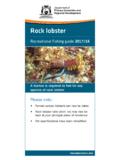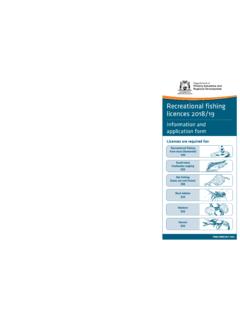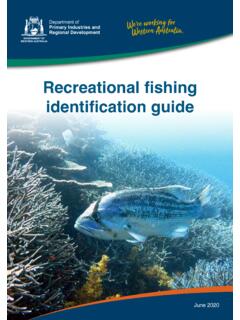Transcription of FISHERIES BARRAMUNDI FACT SHEET - fish.wa.gov.au
1 Page 1 of 4 BarramundiLates calcariferBarramundi icon of the KimberleyBarramundi are a highly opportunistic species that dominate many tropical rivers. Delicious and thrilling to catch, they also live in both freshwater and saltwater, change sex and eat just about anything. BARRAMUNDI support substantial commercial, recreational and customary FISHERIES , as well as an aquaculture industry broad distributionBarramundi are distributed throughout coastal areas of the Indo-West Pacific region from the eastern edge of the Persian Gulf to China, Taiwan, southern Japan southward to Papua New Guinea, and northern Australia. In Western Australia, BARRAMUNDI are found in rivers and along the coast from Exmouth Gulf to the Northern Territory border, however, they are most prolific in the Kimberley where a large area of the State s tropical rivers are s in a name? BARRAMUNDI belong to the sea perch family of fishes (Centropomidae) and are distantly related to the famous Nile perch of Africa.
2 Internationally, BARRAMUNDI are also known as Asian sea bass, giant perch, or giant sea have not always had such an iconic name in Australia, and were once known as Asian sea bass. In the 1980 s, BARRAMUNDI was appropriated for marketing reasons. Prior to this, BARRAMUNDI was believed to be an Aboriginal word initiated from the Rockhampton area meaning large scale river fish . This is thought to have originally referred to another large freshwater fish, the saratoga. The earliest recorded form is burra-mundi .Distribution of BARRAMUNDI in AustraliaBarramundi have the potential to travel great distances in their life; one fish that was tagged and released had travelled 622 kilometres before recaptured. BARRAMUNDIPUBLISHED JUNE 2011 FISHERIES FACT SHEET Page 2 of 4An exponential relationship exists between the length and fecundity (the number of eggs produced) of female BARRAMUNDI . The larger the female fish, the more eggs she will produce up to 32 million eggs can be produced during a breeding season.
3 That s a lot of eggs!Not fussy with foodBarramundi are opportunistic predators and eat just about anything that lives in the water. This includes insects, spiders, prawns, fish, other BARRAMUNDI and even crocodiles! In fact, a BARRAMUNDI can consume up to 60 per cent of its own size of prey is largely determined by the size of the BARRAMUNDI . The diet of larger BARRAMUNDI consists of 60 per cent fish and 40 per cent crustaceans, while smaller BARRAMUNDI eat mostly small water temperatures cool during the dry seasons (May to August), BARRAMUNDI become less active and eat less frequently. During the build-up to the wet season, water temperatures can be up to 10 C higher than during the dry season, and BARRAMUNDI activity increases with the warmer complex life cycleBarramundi have a complex life cycle that includes freshwater, estuarine and marine phases. Generally, in the wet season, sexually mature adults migrate from fresh water to coastal estuaries assisted by heavy flooding of rivers and September and March in the shallow mudflats of the estuaries, the fish have the most favourable temperature and salinity conditions for spawning, as a result of the build-up of the wet season.
4 Spawning tends to take place at night around the time of the slack tide and appears to be related to the lunar cycle. Nights following full and new moons are the periods of greatest spawning hatched larvae settle into either temporary tidal habitats or coastal swamps, which appear to act as nursery areas for individuals up to one year old. These juvenile BARRAMUNDI develop in the mangrove and floodplain lagoons during their first year, and then move into shallow coastal seas before migrating back to the freshwater rivers and streams. Here they remain for the next three to four years while developing into adults. If they do not have access to freshwater, they will remain in coastal and estuarine BARRAMUNDI become sexually mature as males at about three to four years old. Males turn into females from about five or six years of age onwards, but require saltwater for this sex change. They can live to at least 20 years of At the beginning of the wet season (October), sexually active adults migrate from freshwater rivers to coastal estuaries to spawn, releasing eggs and sperm into the water.
5 A large female can produce up to 32 million eggs during the spawning Only 24 hours after fertilisation, the BARRAMUNDI is almost ready to hatch from the After hatching, larvae are not yet fully developed. The eyes and mouth are closed and the larvae must rely on an internal supply of nutrients from the yolk High tides and wet season floods wash eggs and larvae into mangrove and wetland habitats. At day two or three of life, eyes and mouth open and the larvae begin searching for food. The first live organisms that larvae eat are small plankton, such as At the end of the wet season (April), floodplains begin to dry and most juveniles migrate upstream to freshwater. Some remain in estuarine After one year, BARRAMUNDI have attained a size between 30 to 40 centimetres and are voracious opportunistic sex changeBarramundi are protandrous hermaphrodites, which means they change sex from male to female. They mature first as functional male fish and then undergo sex change to become female.
6 Studies have shown there is a relationship between size and sex. Most BARRAMUNDI mature as males at about 50 to 60 centimetres and start to change sex at around 80 centimetres, but only if they are living in marine freshwater impoundments, such as Manton Dam in the Northern Territory and Tinaroo Dam in Queensland, BARRAMUNDI were introduced for the enjoyment of recreational fishers. Here, you can find BARRAMUNDI weighing over 20 kilograms and over 100 centimetres long, however they are all males. Because of this, restocking is the only way to replenish BARRAMUNDI populations in these freshwater impoundments. It is believed that saltwater triggers sexual maturity in males and that they need to spawn at least once before changing into Illustration Richard mm2-3 mm5-6 mm15-20 mmPage 3 of 4 Freshwater BARRAMUNDI have a much darker upper body, a golden underbody, dark fins, deep girth and a thick tail. The body contains large fat deposits, especially those living in land-locked lagoons.
7 The flesh of these fish often has a muddy or earthy flavour when have the structure and form of the adult fish. The only distinguishing juvenile characteristic, other than size, is the presence of a white dorsal head stripe in fish between one and five centimetres in length. The intensity of the stripe varies with the physiological state of the fish the stripe is most obvious when individuals are to fish for Barra are highly targeted by recreational fishers. They are famous for their great tenacity when hooked, and are a great game and sports fish. Many visitors to Western Australia s top end attempt to bag themselves an elusive metrey (a BARRAMUNDI measuring in excessive of a metre and weighing anywhere between 10 and 25 kilograms).Important commercial catchBarramundi have gained a reputation as one of Australia s finest eating fish and as a result are the most important freshwater-estuarine commercial fish in Australia. The commercial fishery is managed through low intensity and minimal impact fishing, limited entry, seasonal and area closures, and gear water dwellersBarramundi inhabit a wide variety of habitats in coastal waters, estuaries and lagoons in clear to turbid water up to 40 metres deep.
8 Most commonly, they are found in rivers and creeks with large catchments and slow, continuous water flow. They prefer water temperatures above 20 C and will take cover around undercut banks, submerged logs and overhanging vegetation. In Western Australia, the main areas of the fishery are the river systems and tidal creek systems of Cambridge Gulf, the Ria coast of the northern Kimberley, King Sound and Roebuck Bay. The fishery is managed primarily through input controls in the form of limited entry, seasonal and spatial area closures and gear restrictions. In 2009, the total commercial catch of BARRAMUNDI was 60 fishing for BARRAMUNDI is a favourite for recreational distinctive formBarramundi can be recognised by a distinct pointed head, concave forehead, large jaw extending behind the eye and a rounded tail fin. They have a dorsal fin with seven or eight strong spines and a second dorsal fin of ten or eleven are well marked differences between BARRAMUNDI taken from saltwater and those taken from freshwater.
9 Saltwater specimens are coloured bluish or greenish-grey on the upper body, silver on the lower body, have yellowish fins and an elongated general body shape. Usually there is no trace of fatty tissue internally. A freshwater juvenile BARRAMUNDI . Photo: Broome Aquaculture CentreBarramundi support a substantial commercial fishery in WA and Australia wide. Photo: Henrique KwongAs a precautionary measure, breeding stock levels are maintained by the implementation of special fishing rules for the Fitzroy River, King Sound, Broome and the Ord River areas, all of which are key fishing locations. Strict bag limits also apply for anglers catching this fish in other areas of the caudal finConcave head profile (hump on the head)Distinct pointed headDorsal fin with strong spinesSecond soft- rayed dorsal finThe survival of BARRAMUNDI larvae and juveniles is highly variable from year to year. Despite the production of many millions of eggs, like with many species of finfish, more than 90 per cent die in the first few weeks or months.
10 The death rate is even higher in years of low rainfall, colder water temperatures, or when food is Australian populations of BARRAMUNDI are thought to be quite separate from each other so they don t intermingle or 4 of 4CR518 JUNE 2011 Fish illustrations INFORMATIONV isit the Department s website at or contact:DEPARTMENT OF FISHERIES HEAD OFFICE3rd Floor, The Atrium, 168 St George s Terrace, Perth 6000 Ph (08) 9482 7333 Fax (08) 9482 7389 e-mail: ABN: 55 689 794 771 This fact SHEET is the nineteenth (No. 19) in a Department of FISHERIES series. ISSN 1834-9382 ReferencesBooksDavis, (1984). Estimation of fecundity in BARRAMUNDI Lates calcarifer (Bloch) using an automatic particle counter. Australian Journal of Marine and Freshwater Research 35, , (1982). Maturity and sexuality in BARRAMUNDI Lates calcarifer (Bloch) in the Northern Territory and south eastern Gulf of Carpentaria. Australian Journal of Marine and Freshwater Research 33, favourite to farmThe Australian farmed BARRAMUNDI industry started in the mid 1980s.








